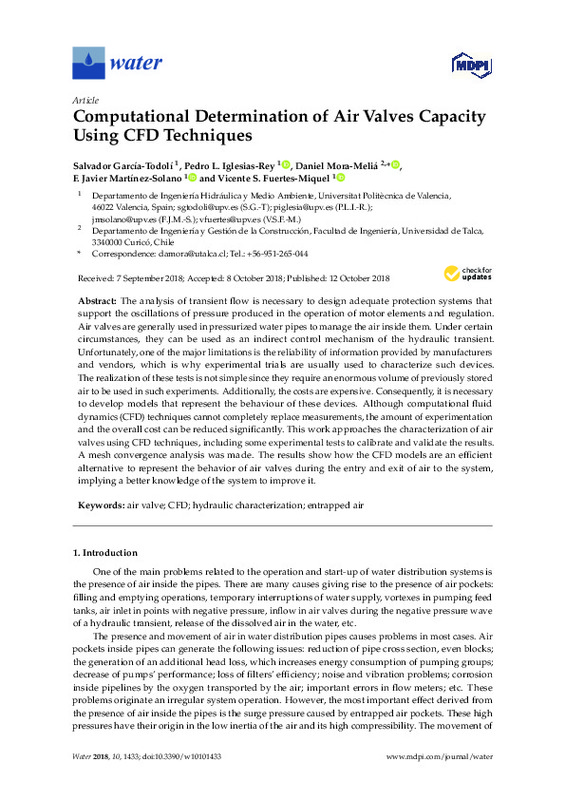Liou, C. P., & Hunt, W. A. (1996). Filling of Pipelines with Undulating Elevation Profiles. Journal of Hydraulic Engineering, 122(10), 534-539. doi:10.1061/(asce)0733-9429(1996)122:10(534)
Zhou, F., Hicks, F. E., & Steffler, P. M. (2002). Transient Flow in a Rapidly Filling Horizontal Pipe Containing Trapped Air. Journal of Hydraulic Engineering, 128(6), 625-634. doi:10.1061/(asce)0733-9429(2002)128:6(625)
Laanearu, J., Annus, I., Koppel, T., Bergant, A., Vučković, S., Hou, Q., … van’t Westende, J. M. C. (2012). Emptying of Large-Scale Pipeline by Pressurized Air. Journal of Hydraulic Engineering, 138(12), 1090-1100. doi:10.1061/(asce)hy.1943-7900.0000631
[+]
Liou, C. P., & Hunt, W. A. (1996). Filling of Pipelines with Undulating Elevation Profiles. Journal of Hydraulic Engineering, 122(10), 534-539. doi:10.1061/(asce)0733-9429(1996)122:10(534)
Zhou, F., Hicks, F. E., & Steffler, P. M. (2002). Transient Flow in a Rapidly Filling Horizontal Pipe Containing Trapped Air. Journal of Hydraulic Engineering, 128(6), 625-634. doi:10.1061/(asce)0733-9429(2002)128:6(625)
Laanearu, J., Annus, I., Koppel, T., Bergant, A., Vučković, S., Hou, Q., … van’t Westende, J. M. C. (2012). Emptying of Large-Scale Pipeline by Pressurized Air. Journal of Hydraulic Engineering, 138(12), 1090-1100. doi:10.1061/(asce)hy.1943-7900.0000631
Apollonio, C., Balacco, G., Fontana, N., Giugni, M., Marini, G., & Piccinni, A. (2016). Hydraulic Transients Caused by Air Expulsion During Rapid Filling of Undulating Pipelines. Water, 8(1), 25. doi:10.3390/w8010025
Zhou, F., Hicks, F. E., & Steffler, P. M. (2002). Observations of Air–Water Interaction in a Rapidly Filling Horizontal Pipe. Journal of Hydraulic Engineering, 128(6), 635-639. doi:10.1061/(asce)0733-9429(2002)128:6(635)
Vasconcelos, J. G., Wright, S. J., & Roe, P. L. (2006). Improved Simulation of Flow Regime Transition in Sewers: Two-Component Pressure Approach. Journal of Hydraulic Engineering, 132(6), 553-562. doi:10.1061/(asce)0733-9429(2006)132:6(553)
Li, J., & McCorquodale, A. (1999). Modeling Mixed Flow in Storm Sewers. Journal of Hydraulic Engineering, 125(11), 1170-1180. doi:10.1061/(asce)0733-9429(1999)125:11(1170)
Ramezani, L., Karney, B., & Malekpour, A. (2015). The Challenge of Air Valves: A Selective Critical Literature Review. Journal of Water Resources Planning and Management, 141(10), 04015017. doi:10.1061/(asce)wr.1943-5452.0000530
Stephenson, D. (1997). Effects of Air Valves and Pipework on Water Hammer Pressures. Journal of Transportation Engineering, 123(2), 101-106. doi:10.1061/(asce)0733-947x(1997)123:2(101)
Bianchi, A., Mambretti, S., & Pianta, P. (2007). Practical Formulas for the Dimensioning of Air Valves. Journal of Hydraulic Engineering, 133(10), 1177-1180. doi:10.1061/(asce)0733-9429(2007)133:10(1177)
De Martino, G., Fontana, N., & Giugni, M. (2008). Transient Flow Caused by Air Expulsion through an Orifice. Journal of Hydraulic Engineering, 134(9), 1395-1399. doi:10.1061/(asce)0733-9429(2008)134:9(1395)
Bhosekar, V. V., Jothiprakash, V., & Deolalikar, P. B. (2012). Orifice Spillway Aerator: Hydraulic Design. Journal of Hydraulic Engineering, 138(6), 563-572. doi:10.1061/(asce)hy.1943-7900.0000548
Iglesias-Rey, P. L., Fuertes-Miquel, V. S., García-Mares, F. J., & Martínez-Solano, J. J. (2014). Comparative Study of Intake and Exhaust Air Flows of Different Commercial Air Valves. Procedia Engineering, 89, 1412-1419. doi:10.1016/j.proeng.2014.11.467
Martins, N. M. C., Soares, A. K., Ramos, H. M., & Covas, D. I. C. (2016). CFD modeling of transient flow in pressurized pipes. Computers & Fluids, 126, 129-140. doi:10.1016/j.compfluid.2015.12.002
Zhou, L., Liu, D., & Ou, C. (2011). Simulation of Flow Transients in a Water Filling Pipe Containing Entrapped Air Pocket with VOF Model. Engineering Applications of Computational Fluid Mechanics, 5(1), 127-140. doi:10.1080/19942060.2011.11015357
Davis, J. A., & Stewart, M. (2002). Predicting Globe Control Valve Performance—Part I: CFD Modeling. Journal of Fluids Engineering, 124(3), 772-777. doi:10.1115/1.1490108
Stephens, D., Johnson, M. C., & Sharp, Z. B. (2012). Design Considerations for Fixed-Cone Valve with Baffled Hood. Journal of Hydraulic Engineering, 138(2), 204-209. doi:10.1061/(asce)hy.1943-7900.0000496
Romero-Gomez, P., Ho, C. K., & Choi, C. Y. (2008). Mixing at Cross Junctions in Water Distribution Systems. I: Numerical Study. Journal of Water Resources Planning and Management, 134(3), 285-294. doi:10.1061/(asce)0733-9496(2008)134:3(285)
Austin, R. G., Waanders, B. van B., McKenna, S., & Choi, C. Y. (2008). Mixing at Cross Junctions in Water Distribution Systems. II: Experimental Study. Journal of Water Resources Planning and Management, 134(3), 295-302. doi:10.1061/(asce)0733-9496(2008)134:3(295)
Ho, C. K. (2008). Solute Mixing Models for Water-Distribution Pipe Networks. Journal of Hydraulic Engineering, 134(9), 1236-1244. doi:10.1061/(asce)0733-9429(2008)134:9(1236)
Huang, J., Weber, L. J., & Lai, Y. G. (2002). Three-Dimensional Numerical Study of Flows in Open-Channel Junctions. Journal of Hydraulic Engineering, 128(3), 268-280. doi:10.1061/(asce)0733-9429(2002)128:3(268)
Weber, L. J., Schumate, E. D., & Mawer, N. (2001). Experiments on Flow at a 90° Open-Channel Junction. Journal of Hydraulic Engineering, 127(5), 340-350. doi:10.1061/(asce)0733-9429(2001)127:5(340)
Chanel, P. G., & Doering, J. C. (2008). Assessment of spillway modeling using computational fluid dynamics. Canadian Journal of Civil Engineering, 35(12), 1481-1485. doi:10.1139/l08-094
Li, S., Cain, S., Wosnik, M., Miller, C., Kocahan, H., & Wyckoff, R. (2011). Numerical Modeling of Probable Maximum Flood Flowing through a System of Spillways. Journal of Hydraulic Engineering, 137(1), 66-74. doi:10.1061/(asce)hy.1943-7900.0000279
Castillo, L., García, J., & Carrillo, J. (2017). Influence of Rack Slope and Approaching Conditions in Bottom Intake Systems. Water, 9(1), 65. doi:10.3390/w9010065
Regueiro-Picallo, M., Naves, J., Anta, J., Puertas, J., & Suárez, J. (2016). Experimental and Numerical Analysis of Egg-Shaped Sewer Pipes Flow Performance. Water, 8(12), 587. doi:10.3390/w8120587
[-]









